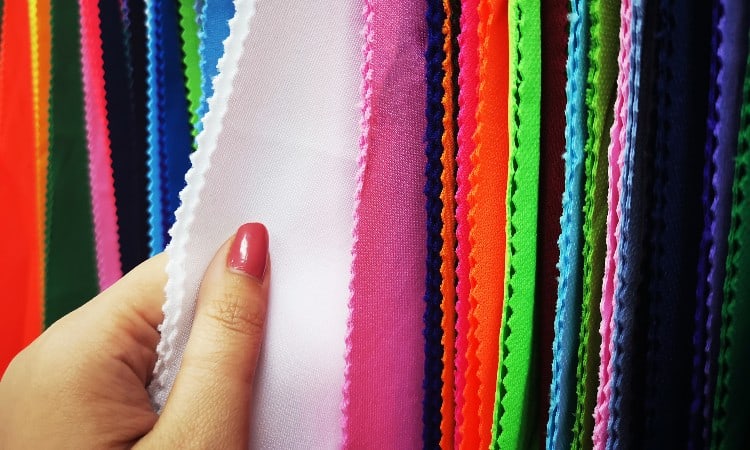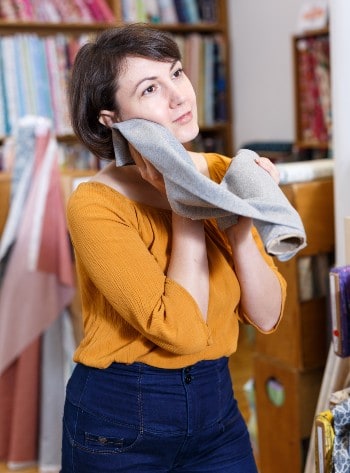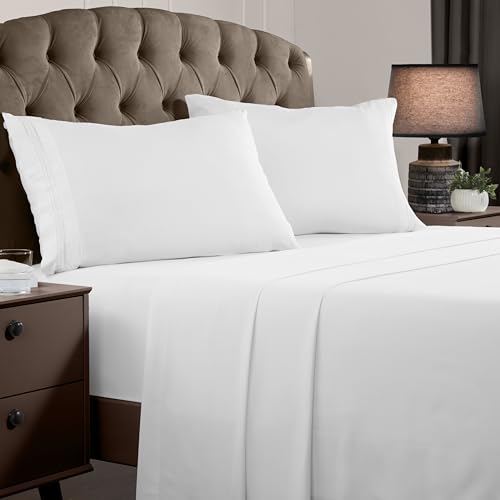Is your closet full of polyester? In recent years, the fashion industry has embraced the incredibly low cost of synthetic materials. If you aren’t familiar with these artificial fabrics, you probably want to find out what polyester feels like and how it compares to natural fabrics.
The softness, texture, and appearance of polyester fabrics vary greatly depending on how the synthetic material is manufactured. Some low-cost polyester has a slightly scratchy texture that feels plasticky. Other forms of polyester feel smooth like silk.
In this article, you’ll learn how polyester is made, what it feels like, and how it compares to other fabrics such as cotton.

What is Polyester?
Polyester fabric is made out of plastic, or polymer, derived from petroleum. While it’s true that you are essentially wearing plastic every time you put on a piece of polyester clothing, it’s also true that textile sciences have advanced so much that many kinds of polyester fabric look and feel almost identical to natural fabrics.
How It’s Made
Here’s a quick look at the science that goes into manufacturing polyester fabric.
Before there is fabric or even thread, there is molten plastic. Manufacturers create this plastic through a process called polymerization, which melds alcohol and acid together. Picture superheated melted plastic oozing through a spout.
That melted polymer hardens into brittle plastic shards. When this hardened plastic melts again, it has a thin consistency and can be spun out through a piece of equipment called a spinneret. At that point, the polymer has become a filament.
This is where things get interesting. Textile manufacturers can use a variety of different processes to turn the polyester filament into the fabric. Each process creates a different kind of fabric with a unique texture and appearance.
First, the polyester fibers can be flat or crimped. Polyester fibers on their own are flat. When left like this, they tend to create the shiny, plasticky kind of material you might associate with a 70s disco suit.
However, manufacturers often treat the fibers by crimping them to give them unique textures. These curly fibers can make a fabric that feels much softer to the touch.
Second, once the fibers are ready to go, manufacturers can choose to twist them into thick or thin filaments. Very thin fibers twisted into very thin filaments create a super-soft fabric such as microfiber. Thick filaments weave into a thicker, coarser kind of fabric.
Third, the way the filaments are either woven or knitted together also impacts the final texture of the material. Knit polyester fabrics have a soft, stretchy texture and feel similar to a cotton knit. Woven polyester usually has a lighter, silkier feel.
Finally, manufacturers can also choose to twist the fibers of another fabric with polyester filaments to create an even wider range of end products. Polycotton, for example, is a super-popular kind of blended fabric.
Kinds of Polyester Fabric

The different techniques used to make polyester result in lots of different kinds of fabrics. Here are just a few examples.
Knit polyester remains a great favorite in the fashion world. A huge amount of the t-shirts sold every year, for example, feature either 100% polyester knit or a blend of polyester and cotton called polycotton.
Microfiber uses the thinnest possible polyester fibers in its super-soft weave. This makes it a great favorite for bedsheets, among other things.
Stiff metal brushes scraped across the fabric create polar fleece, a popular polyester for chilly weather.
What is Polyester Fabric Used For?
Well, not to put too fine a point on it–these days, polyester shows up in almost everything made out of fabric! You can find polyester in the upholstery on your living room couch, in the jacket you wore out into the rain today, and in the t-shirt you bought to support your kid’s band.
You may have thought the description of how to manufacture polyester sounded intensely complex. However, this process costs a lot less making most natural materials.
Because polyester is so cheap, it has found its way into pretty much every aspect of the fashion industry, home goods, and sportswear. You will very likely find at least some percentage of polyester in:
- Sportswear such as leggings and workout shirts. Polyester has great moisture-wicking abilities, meaning that it can suck away the sweat from your skin and allow it to evaporate into the air!
- Jackets and coats. Polyester isn’t a great insulator on its own but paired with a warm lining, it provides excellent protection from wind and rain because of its water-repellent abilities.
- T-shirts. Everyone loves t-shirts to promote a cause, display a funny saying, or wrap you in coziness on a day off work! Knit polyester looks and feels similar to cotton knit, and makes comfy, cheap t-shirts.
- Home goods such as bed sheets, curtains, and blankets. Microfiber bed sheets provide a soft, cool sleeping surface without the high cost of cotton!
What Does Polyester Feel Like?
 Polyester fabric can have a variety of different textures depending on how it is made. This means that you might find a polyester dress shirt that feels cheap and crinkly sold by one brand and a smooth, soft polyester knit sold by another brand.
Polyester fabric can have a variety of different textures depending on how it is made. This means that you might find a polyester dress shirt that feels cheap and crinkly sold by one brand and a smooth, soft polyester knit sold by another brand.
In general, though, polyester fabric has certain shared characteristics.
Softness
The softness of polyester depends on its manufacturing process. These days, textile sciences have advanced to the degree that polyester can mimic many different kinds of natural fibers, including silk, very successfully.
However, depending on the process used to turn it into cloth, it can also have a rougher weave that catches on your fingertips as you smooth them across its surface.
In the early days of synthetic fabrics, polyester was often sold as something called “double-knit” with a rough, scratchy surface. Today, even 100% polyester has a fairly smooth surface, though it can have a shiny and slightly sticky feel.
People argue about whether microfiber or cotton feels softer. You will have to decide for yourself! Either way, you can see that polyester can be extremely soft, depending on how it is made.
Comfort
Is polyester comfortable? Many factors go into determining whether or not you find a garment comfortable, including how it is cut, how it fits your particular body type, and how the fabric feels.
If you focus just on the feel of the fabric, though, some people do find it hot and clingy. This is because polyester fibers lack pores. Many natural fibers allow air to circulate, but polyester fibers do not.
However, while 100% polyester lacks breathability, it is often blended with natural fabrics to create a more breathable poly-blend. You may find this more comfortable than 100% polyester.
Some people do have an allergic reaction to the chemicals used to treat synthetic fabrics. If you find yourself itchy or uncomfortable while wearing polyester, you should choose natural fabrics instead!
Most people, though, find polyester quite soft and comfortable, aside from the potential breathability issue.
Thickness
The weight of any fabric depends entirely on how the material is crafted. Polar fleece, for instance, can be more than half an inch thick! Polyester sateen, on the other hand, may feel as thin and light as a wisp of silk.
What Does Polyester Look Like?

You’re probably tired of hearing this by now, but polyester’s appearance varies based on how the fabric is made. In general, polyester has a silk-like appearance. People often describe this fabric as slightly shiny and quite smooth.
The tricky thing in describing polyester is that this versatile synthetic fabric could be hiding anywhere. Manufacturers today sell fabrics that look like jute, silk, cotton knit, and velvet–but each one is made out of polyester!
Because of this, polyester is often hiding in plain sight. It can look like many different kinds of fabrics.
100% Polyester Texture
People often describe the texture of 100% polyester as smooth, slippery, or silky. When fine, flat polyester fibers are twisted into delicate threads and woven together, the fabric that emerges does feel like silk.
Of course, even 100% polyester can have many different textures depending on whether the filaments are fine or thick and woven or knitted!
You will also often find synthetic fabrics described as having a “plasticky” texture. Think of the outer lining of your winter coat or the smooth, synthetic feel of a tent or umbrella.
What are the Pros and Cons of Polyester?
The biggest advantage of polyester is its affordability, while the biggest disadvantages are its lack of breathability and its environmental impact. Here are a few pros and cons of polyester to consider:
- Low cost. Producing synthetic fabrics is more cost-effective than manufacturing natural fibers. For this reason, the fashion industry has embraced polyester and uses it in practically everything!
- Durability. Polyester lasts forever! It is wind-resistant, water-resistant, mold-resistant, and even flame-resistant. It also holds its shape well and does not wrinkle easily.
- Moisture-wicking. Many people like polyester in their athletic wear because it allows moisture to dissolve into the air instead of getting soaked and staying wet like cotton.
- Versatility. Now, you may consider this a pro or a con, but it’s inarguable that polyester has made its way into almost everything made out of fabric!
- Breathability. This is a definite disadvantage. Depending on how the fabric is woven, air may pass through the gaps in the threads. However, air cannot flow through the polyester fibers. This can create a clingy feel to the fabric.
- Environmental concerns. The other large disadvantage to polyester is that it is not biodegradable and contributes significantly to plastic pollution.
Is Polyester Clingy?
Many people do find polyester a bit clingy. Its tendency toward static electricity causes this clinginess.
Most synthetic materials will collect an electrostatic charge in a dry environment as they rub against another surface. Polyester holds a charge more easily than some other fabrics.
This static can cause your hair to stick to your clothes, and it can also make your clothes cling to your skin.
To prevent static build-up in your garments, try adding a dryer sheet to your next load of laundry. Better yet, hang up your polyester clothing to air dry.
You can also rub a little lotion onto your hands in a pinch and then smooth them over the garment.
Is Polyester Shiny?
Polyester does often look shiny. It has very regular and smooth filaments, which give it a smooth and slightly satiny surface.
Some people like this slight shine. If you like to wear fun, floaty sundresses or ruffled blouses, you have probably noticed how much polyester can resemble silk and satin!
However, sometimes this “shininess” can cause synthetic materials to look a bit fake or plasticky.
Silk fibers have a translucent quality that allows light to seep through them, creating a shimmery luster over the fabric. Polyester fibers are not transparent. When light hits its surface, it reflects off of the fabric.
Polyester vs. Natural Fabrics
Most of the time, cotton is softer than polyester. However, this varies based on how the cotton and polyester are processed. For example, ringspun and Pima cotton has a high price tag but also amazing softness far beyond the mid-level softness of the average cotton knit t-shirt. Microfiber far outshines knit polyester in terms of softness.
When buying clothing or household items, people often wonder how polyester feels compared to natural fabrics like cotton and silk. If you try on a silk shirt and then try on a polyester shirt, you will probably find yourself fingering the synthetic fabric and wondering why it feels cheap in comparison.
Most people don’t object to the feel of polyester and even find it quite comfortable. However, natural fabrics do tend to have a softness and richness in their texture that synthetic fabrics just haven’t quite mastered yet.
This does vary on a case-by-case basis, though!
Let’s consider a common difficulty you may face while shopping for household items. Everyone has to buy new bedsheets once in a while. These days, you have what can seem like an endless array of options!
Should you pick cotton, silk, or microfiber? What thread count do you want?
If you can afford silk sheets, buy silk sheets. Forget about the cotton vs. polyester question! (Just kidding, you may still want to try out the different feels of each textile to see which you like best!).
Cotton costs more than synthetic fabrics, so there’s that to consider. A higher thread count will mean softer sheets, though obviously, you pay for the added softness with a higher price tag! Plus, cotton will soften even further over time as you wash the bedding.
People do argue about whether or not microfiber is softer than the average cotton. Again, thread count can make a difference. That said, a set of microfiber sheets typically costs only half as much as cotton sheets!
Microfiber sheets allow for easy care since they do not wrinkle easily, unlike cotton. However, they do tend to pill over time instead of improving with age.
So, which will you like better? Only you can decide if you prefer economy over luxury or if you find the cool softness of microfiber just as appealing as the natural softness of cotton.
Should You Buy Polyester?
One way to decide whether or not you should buy polyester is to make yourself more aware of the “ingredients” that make up your clothing. There is a simple way to determine if a garment is made of polyester: check the manufacturer’s label inside!
You will find this label either at the back of the neck, at the waistband, or near the hem on the left side for most garments. This label will list the exact percentage of polyester (and other kinds of fabric) in the garment.
You may also want to consider the trade-off of cost vs. environmental concerns. Many consumers object to the prevalent use of plastics, especially in the fashion industry. Polyester is not biodegradable and can harm the environment.
However, a huge amount of ready-wear clothing sold worldwide contains polyester because it is so cheap. The low cost of synthetic fabrics is what allows us to pop into a Kohls or Target and buy a new dress for every special occasion.
You will have to decide for yourself if you value the accessibility of ready-made fashion over the potential environmental impact.
For many consumers, polyester seems so prevalent that it’s a lot harder not to buy it than to buy it!
Here are a couple of sample products to give you an idea of the many different places you can find polyester fabric!
Mellanni Bed Sheet Set
 Mellanni bed polyester sheets have an incredibly high 1800 thread count! They come in a wide variety of colors, patterns, and sizes, from twin to California King. Their durable microfiber allows for machine washing with no wrinkling.
Mellanni bed polyester sheets have an incredibly high 1800 thread count! They come in a wide variety of colors, patterns, and sizes, from twin to California King. Their durable microfiber allows for machine washing with no wrinkling.
People describe these sheets as cool and relaxing as well as silky and soft. Customers also remark that this sheet set has very thin fabric, so if you prefer a thick weave, this may not be the set for you. However, for most users, the softness outweighs the lightweight weave!
Hanes Sport Womens V-Neck Tee
 This loose-fitting v-neck tee comes in seven different colors. Made of stretchy 100% poly jersey knit, it will provide comfortable ease of movement for any athletic activity.
This loose-fitting v-neck tee comes in seven different colors. Made of stretchy 100% poly jersey knit, it will provide comfortable ease of movement for any athletic activity.
It is machine washable and resists wrinkling or fading, making it an excellent choice for outdoor wear as well.
People describe the colors of these shirts as bright and vibrant. They also remark on the coolness of the fabric and the easy comfort it provides during a workout.
Conclusion
By now, you probably feel like an expert on fabric manufacturing! Understanding the processes that go into making different styles of material will help you know what fabric fits your needs. Comparing polyester to other natural fabrics also gives you a better sense of whether you will find polyester comfortable.
Have you purchased anything made out of polyester fabric lately? Did you find it comfortable, or do you find that you prefer cotton? Leave a comment below to let us know!